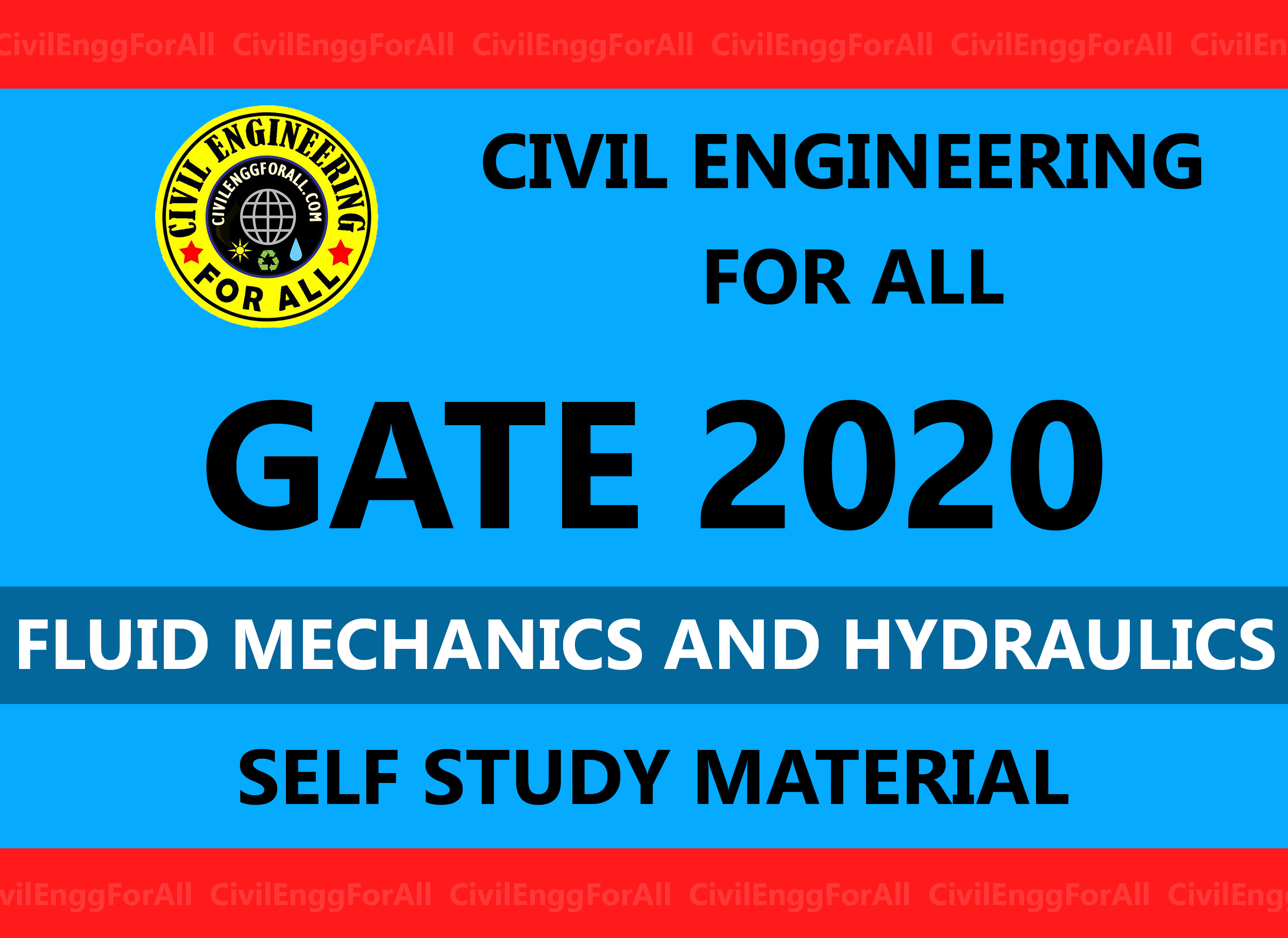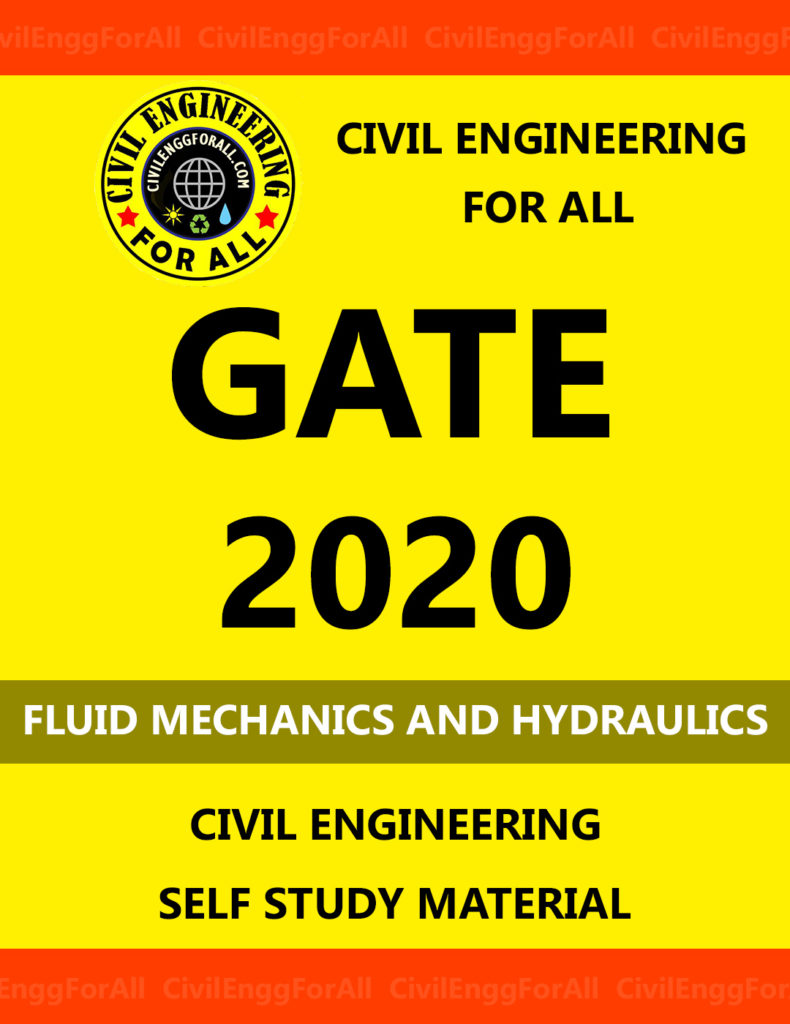

CONTENTS
- Physical Properties of Fluids
- Water as a Fluid
- Variation of Static Pressure
- Hydrostatics
- Buoyancy and Floatation
- Fluid Kinematics
- Fluid Dynamics
- Momentum Equation
- Viscous Flow
- Pipe Flow
- Boundary Layer Theory
- Flow in Pipes
- Pipe Network
- Forces on Immersed Bodies
- Flow Measurement
- Dimensional Analysis
- Model Analysis
- Velocity Triangle
- Turbomachinery
- Centrifugal Pumps
- Open Channel Flow
- Celerity (C)
- Steady Uniform Flow
- Critical Flow in a Channel
- Application of Specific Energy
- Hydraulic Jump
- Open Channel Surges
- Gradually Varied Flow (GVF)

1. Mass density (ρ)- It is mass per unit volume. Mass Denstiy = Mass/Volume Dimensionally: Mass Density = ML–3 Unit of mass density in MKS system = metric slug/m3, in SI system = kN/m3
2. Specific weight (γ) – It is weight per unit volume, γ = ρ x g Unit: MKS system – kg/m. SI – Newtons/m3, γ (SI) = γ (MKS) x 9.81. For water, γ = 9810 N/m3
3. Specific volume – It is defined as volume per unit mass. Unit of specific volume in MKS system = cubic metre/metric slug whereas in SI system it is measured in m3/kg.
4. Specific Gravity – It is ratio of the density of liquid to that of pure water at 4°C and at a pressure of 760 mm of mercury at mean sea level.
IES MASTER CIVIL ENGINEERING GATE STUDY MATERIALS PDF: DOWNLOAD LINK
ACE ACADEMY CIVIL ENGINEERING GATE STUDY MATERIALS PDF: DOWNLOAD LINK
5. Viscosity – It is the property by virtue of which a fluid offers resistance to deformation under the influence of a shear force. Fluid undergoes a continuous deformation as long as a shear force is applied. When shear force is removed, the fluid particles remain in their new positions. For a given fluid, the rate of deformation is dependent upon magnitude of the shear force. Viscosity measures internal fluid friction purely due to cohesion.
6. Dynamic Viscosity – For a steady uniform flow, shear stress τ (tau) between two adjacent layers is proportional to velocity gradient in the direction perpendicular to the layers.

i.e. τ α du/dy => τ = μ du/dy
7. Specific Viscosity: It is defined as a ratio between dynamic viscosity of a fluid and dynamic viscosity of water at 200C in centipoise. Water at 20C has viscosity of 1.0 cP
8. Kinematic Viscosity – It is the ratio of dynamic viscosity and mass density
ACE ACADEMY CIVIL ENGINEERING GATE HANDWRITTEN CLASSROOM NOTES PDF: DOWNLOAD LINK
MADE EASY CIVIL ENGINEERING GATE HANDWRITTEN CLASSROOM NOTES PDF: DOWNLOAD LINK
Classification of Fluids

- Newtonian Fluids – A fluid which obeys Newton’s law of viscosity is called Newtonian fluid. Newtonian fluids have a certain constant viscosity, i.e. viscosity is independent of the shear stress.
- Non-Newtonian Fluids – These fluids exhibit non-Newtonian characteristics, i.e., shear stress is not linearly dependent upon velocity gradient and therefore, do not follow Newton’s law of viscosity. It is evident that Newtonian fluids may exhibit non-Newtonian characteristics under conditions of higher shear stress, and hence classification of a fluid may change with the condition of flow.
Types of Non-Newtonian Fluids
(i) Time-independent Fluids – In these fluids rate of deformation or velocity gradient depends only upon the shear stress. Below are the types of Time independent fluids
- Thixotropic fluids: These are those which show an increase in apparent viscosity with time.
- Rheopectic fluids: These show a decrease in the apparent viscosity with time.
(b) Time-dependent Fluids – In these fluids, the rate of deformation and viscosity depends upon both the shear stress and duration of its application.
Bingham plastic fluids: These require a certain minimum shear stress τy called yield stress before they start flowing.
Vapour Pressure – When evaporation takes place within an enclosed space, partial pressure created by the vapour molecules at its free surface is called vapour pressure. Vapour pressure depends upon temperature and increases with it.
Surface Tension – Within the body of a liquid, a molecule is attracted equally in all directions by other molecules surrounding it, but molecules at the surface have a net downward force which is perpendicular to the surface. Hence it requires work to move molecules to the surface against this opposing force and the surface molecules have more energy than interior ones. This energy give rise to tensile force acting on the surface and has a tendency to shrink the surface so as to have the minimum surface area. This phenomenon is called surface tension (σ). In SI units it is measured in N/mm. Surface tension decreases as temperature of the liquid increases and at critical temperature of the liquid it becomes zero. Surface tension of water in contact with air varies from 0.0736 N/m at 190C to 0.0589 N/m at 1000C. Surface tension of mercury is 0.4944 N/m.
Capillarity – The liquid for which adhesion dominates, rise of liquid in capillary tube takes place to balance decrease in pressure. While for liquid and solid medium combination, where cohesion of liquid dominates over adhesion between liquid and solid. The liquid surface gets depressed down in capillary tube.
Compressibility – It is the measure of change of volume (or density) when a substance is subjected to pressure.
FLUID MECHANICS IES MASTER GATE STUDY MATERIAL PDF: DOWNLOAD LINK
FLUID MECHANICS ACE ACADEMY GATE STUDY MATERIALS PDF: DOWNLOAD LINK
BUOYANCY AND FL OATATI ON
Archimedes Principle – When a body is totally or partially immersed in a fluid, it is lifted up by a force which is equal to weight of the fluid displaced by the body. This vertical upward force is called center of buoyancy (C.B) and it is at the center of gravity of the displaced fluid.
Stability of Submerged Bodies – For stability of submerged body, center of gravity of the body must lie directly below the center of buoyancy (gravity) of the displaced fluid. The submerged body is in neutral equilibrium of all positions as long as the w.f. of the body and C.B. coincides.
Floatation – A body immersed in any fluid is acted upon by weight of body W acting vertically downward and buoyant force Fb acting vertically upwards. If W > FB, the body will sink. If W = FB, the body will remain in equilibrium at any level. If W < FB, the buoyant force will move the body upwards and body will come to rest, when buoyant force becomes equal to its weight. Then the body is said to be floating.
Principal of Floatation – The weight of a floating body is equal to the weight of fluid displaced by the body. Centre of buoyancy It is the point from which the buoyancy force acts. And it acts at the centroid of displaced void.
Stability of Floating bodies – For stability of floating cylinder or spheres, center of buoyancy (C.B.) should lie considerably below the Center of gravity (G) the body. Stability of other floating bodies will depend upon whether a righting or overturning moment is developed when w.f. and C.B. move out of the vertical alignment due to shifting of the position of C.B. The C.B. will shift because of the floating body tilts, the shape of displaced liquid changes and hence its w.f. shifts.
Metacenter – It is the point of intersection of line joining previous C.B. and center of gravity (G) and vertical through the new C.B.
TURBOMACHINES – Fluid machine is a device either for converting energy held by a fluid into mechanical energy or vice versa. Machine in the former case in called turbine and in the later case is called a pump. If energy is directly converted by reciprocating movement of a piston inside a cylinder, the machine is called engine or motor or reciprocating pump. Thus in turbines fluid does work on the rotor (called runner) and in pump, the rotor (called impeller) does work on the fluid.
Turbine Classification – Turbines are classified on the following basis:
1. Based on Pressure at the inlet or principle of working.
- Impulse Turbine: Pelton Wheel, Turbo Impulse Turbine
- Reaction Turbine: Forneyron, Old and modern Francis Kaplan, Propeller, Deriaz, Tubular or Bulb turbine.
2. Based on Direction flow
- Tangential flow: Pelton
- Radial flow: Turbon Impulse, Old Francis, Forneyron
- Axial flow: Kaplan, Propeller, Turbular/Bulb Turbine
- Mixed flow: Modern Francis Turbine
- Diagonal flow: Deriaz Turbine
3. Based on Operating Head
- Low Head (2-15m): Kaplan,
- Medium Head (16-70m): Kaplan, Francis, Turbo Impulse
- High Head (71-500): Francis, Pelton, Deriaz (upto 300m)
- Very High Head (> 500m): Pelton.
4. Specific Speed

FLUID MECHANICS AND HYDRAULICS CIVIL ENGINEERING GATE 2020 STUDY MATERIAL FREE DOWNLOAD PDF
DOWNLOAD LINK : CLICK HERE
PASSWORD : CivilEnggForAll
OTHER USEFUL BOOKS
- CIVIL ENGINEERING TEXTBOOKS WITH DOWNLOAD LINKS
- IES MASTER CIVIL ENGINEERING GATE STUDY MATERIALS PDF
- ACE ACADEMY CIVIL ENGINEERING GATE STUDY MATERIALS PDF
- BUILDING MATERIALS – MOCK TEST 1 (QUICK)
- TELANGANA STATE PUBLIC SERVICE COMMISSION – ASSISTANT ENGINEER 2023 – TSPSC AE 2023 CIVIL ENGINEERING EXAM SOLVED PAPER WITH EXPLANATIONS PDF FREE DOWNLOAD
- SSC JE 2023 CIVIL ENGINEERING (CPWD/CWC/MES) EXAM SOLVED PAPER PDF FREE DOWNLOAD
- BIHAR PUBLIC SERVICE COMMISSION ASSISTANT ENGINEER (BPSC AE) 2022 CIVIL ENGINEERING EXAM SOLVED PAPER WITH EXPLANATIONS PDF
- NHPC (NATIONAL HYDROELECTIC POWER CORPORATION) JUNIOR ENGINEER NHPC JE 2022 CIVIL ENGINEERING EXAM SOLVED PAPER PDF FREE DOWNLOAD

Leave a Reply